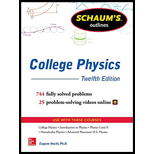
Show that 1.00 Wb = 1.00 V • s. [Hint: Use Faraday’s Law, Eq. (32.4).]
To prove:
Explanation of Solution
Given data:
The value of fluxis
Formula used:
The magnitude of induced emf in a coil is expressed as,
Here,
Explanation:
Recall the expression for the magnitude of induced emf in the coil.
Rearrange for
For 1 turn,
Substitute 1 for
Write the unitsof
The unit of
Substitute
Conclusion:
Want to see more full solutions like this?
Chapter 34 Solutions
Schaum's Outline of College Physics, Twelfth Edition (Schaum's Outlines)
- Pls help ASAParrow_forward9. When an electron moves into a uniform and perpendicular magnetic field, it will.. a. Accelerate parallel to the magnetic Field until it leaves b. Accelerate in a circular path c. Accelerate perpendicular to both the magnetic field and its original direction d. Repel back into the electric field 10. If a proton at rest is placed in a uniform magnetic field with no electric or gravitational field around, the proton will…….. a. Accelerate in the direction of the magnetic field b. Accelerate in a direction perpendicular to the magnetic field c. Move in a circular path d. Not acceleratearrow_forward7. The electric field at a distance of 1.0 mfrom a charged sphere is 100 N/C. At what distance from thesphere will the electric field be 50 N/C? a. 1.1 m b. 1.4 m c. 2.0 m d. 4.0 m 8. The electric potential due to a point charge at a point depends on a. The direction of the electric field b. The distance from the point charge c. The velocity of the point charge d. The mass of the point chargearrow_forward
- Pls help ASAParrow_forward5. The amount of energy required to move 1 C of charge from one location to another is called.. a. Electrical Potential Energy b. Potential Difference c. Electric Field d. Mechanical Energy 6. If a charge of -q exerts a force of F on a charge +3q, then the charge +3q will exert a force of a. 3F b. -3F on charge -q. C. F d. -Farrow_forwardTwo lenses are separated by 20cm distance each one has focal length |f|=10. Draw the ray diagram and find the finalimage distance if the object is 40cm away from the lens 1 with s1=40cm for the following casesa)First lense is covex the second one is convexb) First one is convex the second one is concavearrow_forward
- 1) A light source is emitting light with 800nm wavelength in a double slit experiment. The separation between the slits is0.01 m and the screen is 5 meters away.a) Find the angle for the fifth and the sixth constructive interferencesb) Find the distance between the third constructive and the third destructive interferences on the screenarrow_forwardA light is passing through a small circular hole with radius 0.002 meters. The third destructive resonance is attheta=0.004 radians. Find the wavelength of the light. Find the angle for the third constructive resonance.arrow_forwardA circular capacitor has 6mm radius. Two parallel plates are 2mm apart. Between the capacitors magnetic field is B=410^-2 Tesla in theta direction at a given time. Calculate the displacement current and change in electric field at thatmomentarrow_forward

 Principles of Physics: A Calculus-Based TextPhysicsISBN:9781133104261Author:Raymond A. Serway, John W. JewettPublisher:Cengage Learning
Principles of Physics: A Calculus-Based TextPhysicsISBN:9781133104261Author:Raymond A. Serway, John W. JewettPublisher:Cengage Learning Glencoe Physics: Principles and Problems, Student...PhysicsISBN:9780078807213Author:Paul W. ZitzewitzPublisher:Glencoe/McGraw-Hill
Glencoe Physics: Principles and Problems, Student...PhysicsISBN:9780078807213Author:Paul W. ZitzewitzPublisher:Glencoe/McGraw-Hill Physics for Scientists and Engineers, Technology ...PhysicsISBN:9781305116399Author:Raymond A. Serway, John W. JewettPublisher:Cengage Learning
Physics for Scientists and Engineers, Technology ...PhysicsISBN:9781305116399Author:Raymond A. Serway, John W. JewettPublisher:Cengage Learning Physics for Scientists and Engineers: Foundations...PhysicsISBN:9781133939146Author:Katz, Debora M.Publisher:Cengage Learning
Physics for Scientists and Engineers: Foundations...PhysicsISBN:9781133939146Author:Katz, Debora M.Publisher:Cengage Learning College PhysicsPhysicsISBN:9781305952300Author:Raymond A. Serway, Chris VuillePublisher:Cengage Learning
College PhysicsPhysicsISBN:9781305952300Author:Raymond A. Serway, Chris VuillePublisher:Cengage Learning





